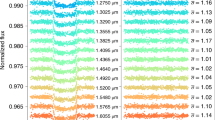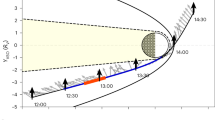Abstract
Widespread hydration was detected on the lunar surface through observations of a characteristic absorption feature at 3 µm by three independent spacecraft1,2,3. Whether the hydration is molecular water (H2O) or other hydroxyl (OH) compounds is unknown and there are no established methods to distinguish the two using the 3 µm band4. However, a fundamental vibration of molecular water produces a spectral signature at 6 µm that is not shared by other hydroxyl compounds5. Here, we present observations of the Moon at 6 µm using the NASA/DLR Stratospheric Observatory for Infrared Astronomy (SOFIA). Observations reveal a 6 µm emission feature at high lunar latitudes due to the presence of molecular water on the lunar surface. On the basis of the strength of the 6 µm band, we estimate abundances of about 100 to 400 µg g−1 H2O. We find that the distribution of water over the small latitude range is a result of local geology and is probably not a global phenomenon. Lastly, we suggest that a majority of the water we detect must be stored within glasses or in voids between grains sheltered from the harsh lunar environment, allowing the water to remain on the lunar surface.
This is a preview of subscription content, access via your institution
Access options
Access Nature and 54 other Nature Portfolio journals
Get Nature+, our best-value online-access subscription
$29.99 / 30 days
cancel any time
Subscribe to this journal
Receive 12 digital issues and online access to articles
$119.00 per year
only $9.92 per issue
Buy this article
- Purchase on Springer Link
- Instant access to full article PDF
Prices may be subject to local taxes which are calculated during checkout



Similar content being viewed by others
Data availability
The data that support the plots within this paper and other findings of this study are publicly available from the SOFIA Data Cycle System at https://dcs.sofia.usra.edu and the Infrared Science Archive hosted by the Infrared Processing & Analysis Center (IPAC)) or from the corresponding author on reasonable request.
References
Pieters, C. M. et al. Character and spatial distribution of OH/H2O on the surface of the moon seen by M3 on Chandrayaan-1. Science 326, 568–572 (2009).
Sunshine, J. M. et al. Temporal and spatial variability of lunar hydration as observed by the Deep Impact spacecraft. Science 326, 565–568 (2009).
Clark, R. N. Detection of adsorbed water and hydroxyl on the moon. Science 326, 562–564 (2009).
McIntosh, I. M., Nichols, A. R. L., Tani, K. & Llewellin, E. W. Accounting for the species-dependence of the 3500 cm−1 H2Ot infrared molar absorptivity coefficient: implications for hydrated volcanic glasses. Am. Mineral. 102, 1677–1689 (2017).
Starukhina, L. Water detection on atmosphereless celestial bodies: alternative explanations of the observations. J. Geophys. Res. 106, 701–710 (2001).
Falk, M. The frequency of the H-O-H bending fundamental in solids and liquids. Spectrochim. Acta 40A, 43–48 (1984).
Li, S. & Milliken, R. E. Water on the surface of the Moon as seen by the Moon Mineralogy Mapper: distribution, abundance, and origins. Sci. Adv. 3, 1–11 (2017).
Takir, D., Stockstill-Cahill, K. R., Hibbitts, C. A. & Nakauchi, Y. 3-μm reflectance spectroscopy of carbonaceous chondrites under asteroid-like conditions. Icarus 333, 243–251 (2019).
Li, S. Water on the Lunar Surface as Seen by the Moon Mineralogy Mapper: Distribution, Abundance, and Origins. PhD dissertation, Brown Univ. (2017).
Wöhler, C., Grumpe, A., Berezhnoy, A. A. & Shevchenko, V. V. Time-of-day–dependent global distribution of lunar surficial water/hydroxyl. Sci. Adv. 3, e1701286 (2017).
Grumpe, A., Wöhler, C., Berezhnoy, A. A. & Shevchenko, V. V. Time-of-day-dependent behavior of surficial lunar hydroxyl/water: observations and modeling. Icarus 321, 486–507 (2019).
Bandfield, J. L., Poston, M. J., Klima, R. L. & Edwards, C. S. Widespread distribution of OH/H2O on the lunar surface inferred from spectral data. Nat. Geosci. 11, 173–177 (2018).
Hibbitts, C. A. et al. Thermal stability of water and hydroxyl on the surface of the Moon from temperature-programmed desorption measurements of lunar analog materials. Icarus 213, 64–72 (2011).
Daly, R. T. & Schultz, P. H. The delivery of water by impacts from planetary accretion to present. Sci. Adv. 4, 1–11 (2018).
Benna, M., Hurley, D. M., Stubbs, T. J., Mahaffy, P. R. & Elphic, R. C. Lunar soil hydration constrained by exospheric water liberated by meteoroid impacts. Nat. Geosci. 12, 333 (2019).
Jones, B. M., Aleksandrov, A., Hibbitts, K., Dyar, M. D. & Orlando, T. M. Solar wind‐induced water cycle on the moon. Geophys. Res. Lett. 45, 959–10,967 (2018).
Zhu, C. et al. Untangling the formation and liberation of water in the lunar regolith. Proc. Natl Acad. Sci. USA 116, 11165–11170 (2019).
Poston, M. J. et al. Temperature programmed desorption studies of water interactions with Apollo lunar samples 12001 and 72501. Icarus 255, 24–29 (2015).
Hendrix, A. R. et al. Diurnally migrating lunar water: evidence from ultraviolet data. Geophys. Res. Lett. 46, 2417–2424 (2019).
McCubbin, F. M. et al. Magmatic volatiles (H, C, N, F, S, Cl) in the lunar mantle, crust, and regolith: abundances, distributions, processes, and reservoirs. Am. Mineral. 100, 1668–1707 (2015).
McKay, D. S. et al. in Lunar Sourcebook (eds Heiken, G. et al.) Ch. 4 (Cambridge Univ. Press, 1991).
Liu, Y. et al. Direct measurement of hydroxyl in the lunar regolith and the origin of lunar surface water. Nat. Geosci. 5, 779–782 (2012).
Hapke, B. Effects of a simulated solar wind on the photometric properties of rocks and powders. Ann. NY Acad. Sci. 123, 711–721 (1965).
Zeller, E. J., Ronca, L. B. & Levy, P. W. Proton-induced hydroxyl formation on the lunar surface. J. Geophys. Res. 71, 4855–4860 (1966).
Ichimura, A. S., Zent, A. P., Quinn, R. C., Sanchez, M. R. & Taylor, L. A. Hydroxyl (OH) production on airless planetary bodies: Eevidence from H+/D+ ion-beam experiments. Earth Planet Sci. Lett. 345-348, 90–94 (2012).
Bradley, J. P. et al. Detection of solar wind-produced water in irradiated rims on silicate minerals. Proc. Natl Acad. Sci. USA 111, 1732–1735 (2014).
Farrell, W. M., Hurley, D. M., Esposito, V. J., McLain, J. L. & Zimmerman, M. I. The statistical mechanics of solar wind hydroxylation at the Moon, within lunar magnetic anomalies, and at Phobos. J. Geophys. Res. Planets 122, 269–289 (2017).
Tucker, O. J., Farrell, W. M., Killen, R. M. & Hurley, D. M. Solar wind implantation into the lunar regolith: Monte Carlo simulations of H retention in a surface with defects and the H2 exosphere. J. Geophys. Res. Planets 124, 278–293 (2019).
Becklin, E. E. & Moon, L. J. Stratospheric observatory for infrared astronomy (SOFIA). Adv. Space Res. 30, 2083–2088 (2002).
Herter, T. L. et al. FORCAST: A Mid-Infrared Camera for SOFIA. J. Astron. Instrum. 7, 1–13 (2018).
Bufton, D. & Yorke, H. Water Vapor Monitor (SOFIA Science Center, NASA/DLR SOFIA, 2018); https://www.sofia.usra.edu/science/instruments/water-vapor-monitor
Guest Observer Handbook for FOCAST Data Products (SOFIA, 2017); https://www.sofia.usra.edu/sites/default/files/USpot_DCS_DPS/Documents/FORCAST_GO_HAndbook_RevC.pdf
Lord, S. D. A New Software Tool for Computing Earth’s Atmospheric Transmission of Near- and Far-Infrared Radiation NASA Technical Memorandum No. 103957 (NASA, 1992).
Thompson, W. K. Infra-red spectroscopic studies of aqueous systems. Part 1. Molar extinction coefficients of water, deuterium oxide, deuterium hydrogen oxide, aqueous sodium chloride and carbon disulphide. Trans. Faraday Soc. 61, 2635–2640 (1965).
Glew, D. N. & Rath, N. S. H2O, HDO, and CH3OH infrared spectra and correlation with solvent basicity and hydrogen bonding. Can. J. Chem. 49, 837–856 (1971).
Hale, G. M. & Querry, M. R. Optical constants of water in the 200-nm to 200-μm wavelength region. Appl. Opt. 12, 555–563 (1973).
Orlova, G. P. The solubility of water in albite melts. Int. Geol. Rev. 6, 254–258 (1962).
Bartholomew, R. F., Butler, B. L., Hoover, H. L. & Wu, C. K. Infrared spectra of a water‐containing glass. J. Am. Ceram. Soc. 63, 481–485 (1980).
Newman, S., Stolper, E. M. & Epstein, S. Measurement of water in rhyolitic glasses; calibration of an infrared spectroscopic technique. Am. Mineral. 71, 1527–1541 (1986).
Pieters, C. M. Strength of mineral absorption features in the transmitted component of near-infrared reflected light: first results from RELAB. J. Geophys. Res. 88, 9534–9544 (1983).
Hapke, B. Theory of Reflectance and Emittance Spectroscopy 1st edn (Cambridge Univ. Press, 1993).
Hapke, B. Theory of Reflectance and Emittance Spectroscopy 2nd edn (Cambridge Univ. Press, 2012).
Williams, J. P., Paige, D. A., Greenhagen, B. T. & Sefton-Nash, E. The global surface temperatures of the Moon as measured by the Diviner Lunar Radiometer Experiment. Icarus 283, 300–325 (2017).
Acknowledgements
Observations were made using the NASA/DLR SOFIA. SOFIA is jointly operated by the Universities Space Research Association, Inc. (USRA) under NASA contract number NNA17BF53C and the Deutsches SOFIA Insitut (DSI) under DLR contract number 50 OK 0901 to the University of Stuttgart.
Author information
Authors and Affiliations
Contributions
C.I.H. and P.G.L. carried out observations and data analysis. Data reduction to physical units of flux was done by S.S. S.L. provided the calibration of absorption to abundance of water and M3 data. C.A.H. provided laboratory meteorite data for 6 µm band comparisons and provided guidance regarding lunar material contributions at 6 µm. T.M.O. and W.M.F. advised C.I.H and P.G.L. on the activation energies, monolayer coverage and surface area estimates. D.M.H. provided the interpretation of these results for the lunar exosphere.
Corresponding author
Ethics declarations
Competing interests
The authors declare no competing interests.
Additional information
Peer review information Nature Astronomy thanks Matthew A. Siegler and the other, anonymous, reviewer(s) for their contribution to the peer review of this work.
Publisher’s note Springer Nature remains neutral with regard to jurisdictional claims in published maps and institutional affiliations.
Extended data
Extended Data Fig. 1 Location map.
LRO WAC Image of the Moon with the slit location of the mare reference and Clavius overlaid.
Extended Data Fig. 2 Z score.
Z score histogram density for all Clavius observations.
Extended Data Fig. 3 Water calibration.
Water bearing glass beads showing a 3 and 6 µm absorption (a) used to derive a relationship between band depth (b) and H2O content (c).
Extended Data Fig. 4 Brightness temperature.
Brightness temperature from the Clavius region. The variation in brightness temperature corresponds to locations of more or less illumination.
Extended Data Fig. 5 Abundance histogram.
Distribution of H2O abundance for all data acquired in the Clavius region.
Extended Data Fig. 6 Zoomed Clavius map.
Left: Image of Clavius crater from quickmap that show the visible image with the SOFIA slit areas show by the white box. Right: The same image of Clavius crater but with the Clemintine UVVIS color ratio overlaid to highlight compositional variations. The SOFIA slit intersects Tycho crater ejecta at lower latitudes.
Supplementary information
Supplementary Information
Supplementary Figs. 1–13 and Tables 1 and 2.
Rights and permissions
About this article
Cite this article
Honniball, C.I., Lucey, P.G., Li, S. et al. Molecular water detected on the sunlit Moon by SOFIA. Nat Astron 5, 121–127 (2021). https://doi.org/10.1038/s41550-020-01222-x
Received:
Accepted:
Published:
Issue Date:
DOI: https://doi.org/10.1038/s41550-020-01222-x
This article is cited by
-
Surface Exospheric Interactions
Space Science Reviews (2023)
-
A solar wind-derived water reservoir on the Moon hosted by impact glass beads
Nature Geoscience (2023)
-
Utilization of a meteorological satellite as a space telescope: the lunar mid-infrared spectrum as seen by Himawari-8
Earth, Planets and Space (2022)
-
Chang’E-5 samples reveal high water content in lunar minerals
Nature Communications (2022)
-
Costly SOFIA telescope faces termination after years of problems
Nature (2022)



